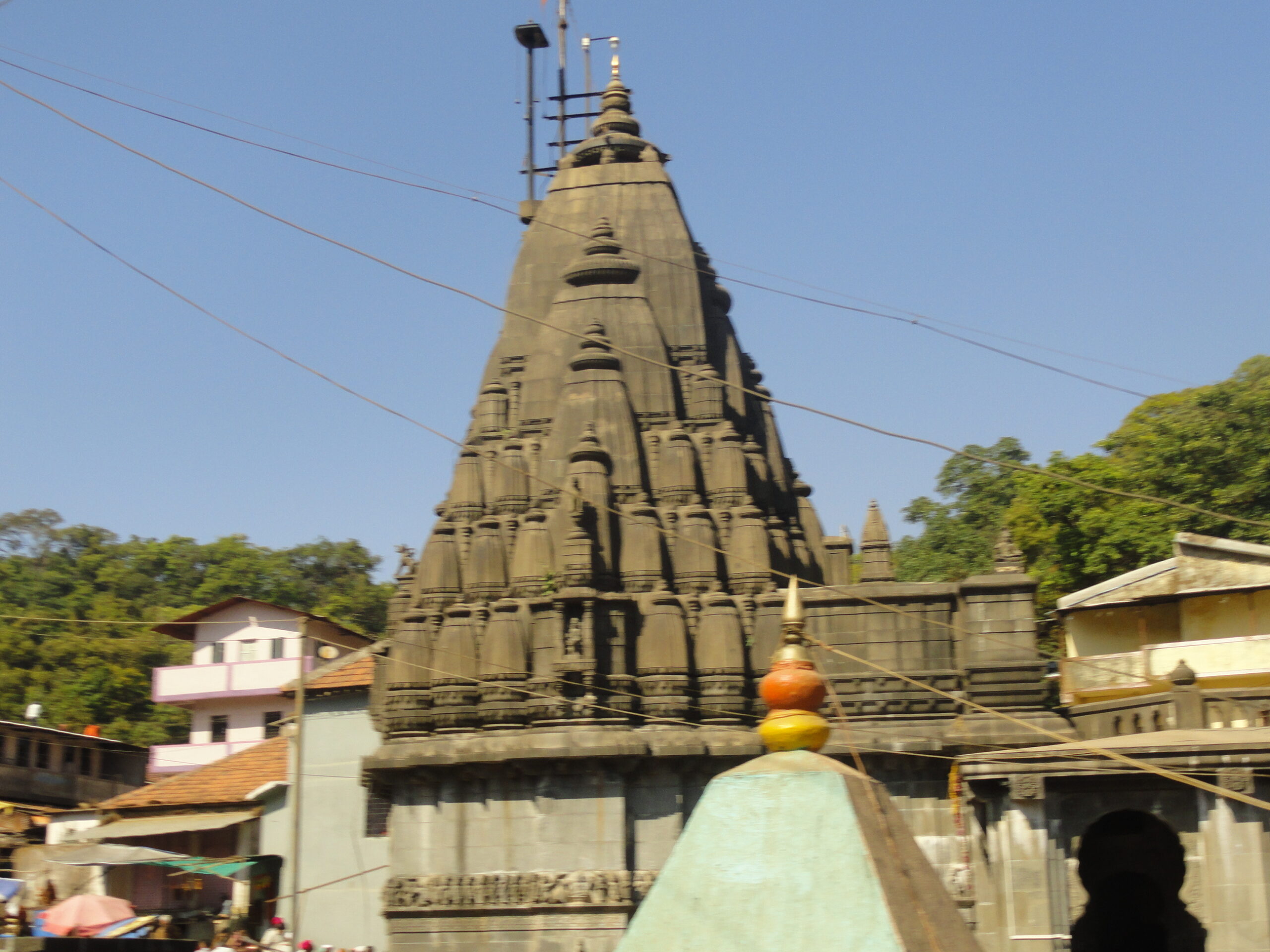Embark on a mystical journey to Bhimashankar Temple, nestled amidst the breathtaking Sahyadri hills. In the realm of Hindu mythology, this sacred site holds captivating tales that weave together history and spirituality. Our trip to Bhimashanker Jyotirlinga was a divine experience we would carry in hearts for our life. A must visit place for everyone.
Bhimashankar Temple History
The history of Bhimashankar Temple is a tapestry of ancient spirituality, profound legends, and architectural evolution, dating back centuries. The original sanctum of this sacred site is believed to have its roots in the 13th century.
13th Century Bhatirao Lakhadhara
The history of Bhimashankar Temple traces back to the 13th century. It is said that a woodcutter named Bhatirao Lakhadhara was diligently working in the dense forests of Dakini, now part of the Sahyadri hills. Legend has it that while engaged in his labor, Bhatirao’s axe struck a particular tree. Astonishingly, the ground beneath the tree began to bleed. News of this extraordinary event quickly spread, and villagers hurried to the scene.
In an act of deep devotion, the villagers offered milk to the wounded tree. Miraculously, the bleeding ceased, leaving everyone in awe. Recognizing this divine occurrence, the villagers united to construct a humble temple at this sacred spot, christening it the Bhimashankar Temple. (ePuja)
Renovations and Devotion
Over the centuries, Bhimashankar Temple underwent various renovations and transformations, each phase adding to its spiritual and architectural grandeur. Notably, the temple received the patronage and attention of several prominent historical figures. Chhatrapati Shivaji, the legendary Maratha warrior king, is said to have visited the shrine to offer his reverence. Peshwa Balaji Vishwanath, a key figure in Maratha history, also paid regular visits to the temple, contributing to its upkeep and conducting religious ceremonies.
One of the most significant additions to the temple complex was the construction of the Shikhar (spire) during the time of Raghunath Peshwa, further enhancing the temple’s architectural beauty and prominence.
Nana Phadnavis’ Contribution
The Diwan of the Peshwas, Nana Phadnavis, played a pivotal role in the temple’s development. His devotion and dedication to Bhimashankar Temple led to the construction of the magnificent Shikhar, a defining feature of the temple’s architecture.
Today, Bhimashankar Temple stands not only as a testimony to the enduring faith of its devotees but also as a remarkable blend of history, spirituality, and architectural excellence. I was amazed to see the beauty of such temple was contribution so many people. Truly a mezmerising fact to know.
Bhimashankar Temple Tales
There are multiple tales which are known for the formation of Bhimashankar Jyotirlinga Temple. I would share two of them. There might various variation in them and please pardon me if I have not done a proper job in describing them. Also please do share your tales in comment section so we all know about different stories around this temple.
Hindu Mythology
According to Hindu mythology, a demon Bhima, the son of Kumbhkarna, and his mother Karkati, lived in the dense forest of Dakini in the Sahyadri hills. On knowing about his father’s death, Bhima got infuriated and vowed to avenge Lord Vishnu.
Bhima performed severe penance (tapasya) to amp up his prowess and please Lord Brahma. After attaining supernatural powers, he gained control over Lord Vishnu and Indra. After this, his ego kept on growing. He asked the greatest devotee of Lord Shiva, Kamarupeshwar, to worship him instead of Lord Shiva. His tyranny and appeal by sages forced Shiva to appear before Bhima. To put Bhima’s havoc to rest.
After the days of the war, Bhima was reduced to ashes. Since then, Lord Shiva has been believed to guard Sahyadri hills. It is said that he is manifested in the form of the Bhimashankar Jyotirlinga.
Shiv Purana
Another captivating tale from the Shiva Purana recounts Lord Shiva’s descent to Earth to vanquish the demon Tripurasura. Tripurasura had brought turmoil to the three worlds (Heavan, Earth and Hell). Their epic battle unfolded near Bhimashankar Temple, culminating in the demon’s defeat.
It is believed that Lord Shiva’s sweat during this battle transformed into the holy Bhima River, which continues to flow through the region and is revered by pilgrims to this day.
As you explore the history and spirituality surrounding Bhimashankar Jyotirlinga Temple, you’ll be immersed in a world where mythology and devotion converge, leaving an indelible mark on all who visit this sacred place.
Bhimashankar Temple Timings
As I said it earlier and I would like to restate it that visiting Bhimashankar Jyotirlinga Temple is a spiritually enriching experience. To help you plan your visit effectively, here are the temple’s opening hours:
Darshan Timings
- Bhimashankar Jyotirlinga Temple opening time is 4:30 AM every day. This early morning start provides a serene and peaceful atmosphere for morning prayers and darshan.
- The temple briefly closes its doors during the afternoon for a few hours to allow for daily rituals and maintenance. Please note that the temple typically closes at 3:00 PM and reopens in the late afternoon.
- The temple reopens in the late afternoon, usually around 4:00 PM, allowing visitors to experience the serene ambiance of an evening darshan until 9:30 PM
Aarti Timings
- Kakada Aarti: 4:30 AM
- Madhyan Aarti: 3:00 PM
- Evening Aarti: 7:00 PM
Abhishek Timings
Devotees could perform Abhishek starting in the morning at 5:30 AM till 12 PM. After 30 min of Naivedya Pooja, Abhishek starts at 12:30 PM till 3:00 PM.
Please note that temple timings may vary on special occasions, festivals, and during religious celebrations. It’s advisable to check with the temple authorities or their official website for any updates or changes in the schedule before planning your visit. Also note that no darshan would be allowed for 45 minutes during Madhyan Aarti
Also Read: Somnath Guide: Timings, History, Weather, and More
What is the significance of Bhimashankar Temple?
What sets Bhimashankar apart is the unique symbolism embedded in its Linga. The Linga is bifurcated by a slender groove, representing both Lord Shiva and Goddess Parvati – a divine union known as “Ardhanareeshwara.” It’s a profound representation of the balance between the masculine and feminine energies in the universe.
A remarkable feature of the Bhimashankar Jyotirlinga is the continuous flow of water from it, a phenomenon that has persisted since time immemorial. This sacred flow is a testament to the temple’s enduring spiritual power and significance.
The nearby Bhima River holds its own sacred allure. Legend has it that this river is none other than the perspiration of Lord Shiva himself, shed during his victorious battle against the demon Tripurasura. Pilgrims often seek solace and purification in its holy waters.
For those in search of deeper spiritual experiences, the Mokshakund, situated behind the Bhimashankar temple, holds great significance. It’s believed to be the very spot where Maharishi Kaushik, also known as Brahmarishi Vishwamitra, engaged in rigorous penance (Tapasya) to appease the Gods.
Visitors to Bhimashankar Temple are not just observers; they’re active participants in their spiritual journey. The temple administration allows pilgrims to perform Abhishekam and Poojas to the Jyotirlinga with marigold and Bilva leaves, fostering a deeper connection with the divine.
Bhimashankar Temple stands as a testimony to the profound spirituality and intricate symbolism embedded in Hindu culture, making it a destination that offers both a spiritual awakening and a deep sense of reverence for Lord Shiva.
Architectural Marvels of Bhimashankar Temple
The Bhimashankar Temple, nestled in the serene Sahyadri hills, showcases a unique blend of architectural styles and cultural richness that makes it an architectural marvel. Here are some notable features of its architecture:
1. Nagara and Hemadpanthi Styles
Bhimashankar Temple is a testament to both Nagara and Hemadpanthi architectural styles. This fusion of styles creates a captivating visual appeal. The Nagara style is characterized by its towering spire and ornate carvings, while the Hemadpanthi style emphasizes simplicity and functionality in construction.
2. Temple Structure
The temple’s structure is relatively simple yet elegant. It consists of three primary components:
-
- Garbhagriha (Sanctum Sanctorum): This innermost chamber houses the sacred Bhimashankar Jyotirlinga, the central deity of worship. The sanctum is known for its divine aura, drawing devotees into its serene ambiance.
- Sabhamandap (Assembly Hall): The spacious hall provides ample space for gatherings, prayers, and religious ceremonies. Its open design allows natural light to filter in, creating a spiritually uplifting atmosphere.
- Kurmamandap: The temple complex also includes a Kurmamandap, which may serve as an extended hall for various rituals and gatherings.
3. Intricate Carvings
The temple’s outer walls are adorned with intricate stone carvings, featuring depictions of various deities and mythological figures. These carvings showcase the exceptional craftsmanship and devotion of the artisans who contributed to the temple’s construction.
4. Wooden Entrance Door
The main entrance of the Bhimashankar Temple is a magnificent wooden door adorned with intricate figures of numerous gods and goddesses. This intricately designed door welcomes visitors into the sacred realm of the temple.
5. Bell and Nandi Statues
At the entrance, a grand bell, gifted by Chimaji Appa, brother of Bajirao Peshwa I, resonates with a melodic chime, announcing the arrival of devotees. Within the temple premises, two significant Nandi statues can be found. One, situated in front of the sanctum, is ancient, while the other is a newer addition.
6. Shrines to Deities
Beyond the Bhimashankar Jyotirlinga, the temple complex encompasses shrines dedicated to various deities, including Lord Shani, Nandi, Lord Ram, and Dutta. These shrines offer devotees opportunities for diverse forms of worship and spiritual connection.
Bhimashankar Temple’s architectural grandeur, coupled with its serene natural surroundings, creates an environment that resonates with spirituality and cultural heritage. It stands as a place of deep reverence and devotion, drawing pilgrims and tourists alike to experience its timeless beauty and divine aura.
Best Time to Visit Shree Bhimashankar Jyotirlinga Temple
Winter is the Best Season (October, November, December, January & February) to visit Shree Bhimashankar Jyotirling Mandir.
How to reach Bhimashankar temple?
- By Air: The nearest airport is Pune, which is 125 km away from the temple.
- By Train: The nearest railway station is Bhimashankar. The direct trains are available from Pune, Mumbai, and Nashik to Bhimashankar at regular intervals.
- By Road: The direct bus is available from Pune to Bhimashankar Temple at regular intervals. The first bus starts at 5:30 am, and the last bus ends at 4:00 pm.
Interesting Facts about Bhimashankar Jyotirlinga Temple
- Bhima’s Footprints: Within the temple complex, you can find a pair of footprints believed to belong to Bhima. These footprints are a reminder of the legendary demon’s presence and the subsequent intervention of Lord Shiva.
- Wildlife Sanctuary: Bhimashankar is not just a religious site but also home to a wildlife sanctuary. The Bhimashankar Wildlife Sanctuary is known for its diverse flora and fauna, including the elusive Indian Giant Squirrel.
- Festivals and Celebrations: The temple comes to life during festivals like Mahashivaratri, Kartik Purnima, and Shravan Somvar, attracting a large number of devotees who come to seek Lord Shiva’s blessings and witness the grand celebrations.
- Spiritual Experience: Many visitors describe their visit to Bhimashankar Temple as a profound and spiritual journey. The peaceful surroundings, ancient rituals, and the sense of divine presence create a unique atmosphere that leaves a lasting impression on all who visit.
Places to Visit in Bhimashankar
Bhimashankar is a very famous religious site. It is among the best places to visit in Maharashtra. If you are traveling here, explore these nearby places to visit in Bhimashankar.
1. Bhimashankar Temple
One of the twelve Jyotirlinga shrines in India, Bhimashankar Temple is the top attraction in this religious destination of Maharashtra. Built-in the 12th century in the Nagara style of architecture, the temple’s walls display iconic scenes from Shiv Puran, Ramayana, Krishna Leela, and Dashavataras. Other than the religious importance, the temple’s location right in the dense forest area also offers a scenic view of nature’s glory to travelers.
2. Bhimashankar Wildlife Sanctuary
Boasting unique foliage, Malabar Giant Squirrels, and many other animal species, Bhimashankar Wildlife Sanctuary is among the most visited places by nature lovers, wildlife enthusiasts, photographers, and adventure junkies. Ideal spot for bird watching and wildlife photography, travelers can expect an incredible experience of discovering a diverse range of flora and fauna. Also, Bhimashankar wildlife sanctuary offers a fascinating trekking experience as scouting through the dense forest is quite a task.
3. Hanuman Lake
Two hours away from Bhimashankar temple, Hanuman Lake is an ideal picnic spot for holidaymakers while they are discovering this offbeat destination from Pune and Mumbai. The pristine lake invites many exotic species from the nearby forests to quench their thirst so one can spot some eye-popping views of witnessing the thriving species in their natural habitat. Carrying your own food with ample water and fun games is highly recommended if you wish to spend a hearty day at this nearby place from Bhimashankar.
4. Manmodi Caves
Located at an altitude of 1000m, Manmodi caves is one of the heritage sites around Bhimashankar that boasts numerous rock structures with ancient illustrious carvings and inscriptions inspired by the revered Jyotirlinga temple nearby. Apart from the traditional Buddhist art style, one can also enjoy the enchanting vistas of Sahyadri hills as these caves are perched right over the hilltop.




